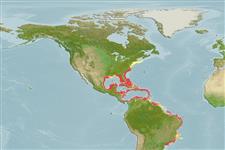Classificação / Names
Common names from other countries
Referência principal
Tamanho / Peso / Idade
Max length : 86.3 cm TL macho/indeterminado; (Ref. 9626); common length : 40.0 cm TL macho/indeterminado; (Ref. 55); Peso máx. publicado: 4.1 kg (Ref. 40637); Idade máx. registada: 14 anos (Ref. 3090)
Length at first maturity
Lm 22.5, range 15 - 31 cm
Ambiente
; marinhas associadas(os) a recifes; intervalo de profundidade 0 - 180 m (Ref. 10795), usually 10 - 70 m (Ref. 55229)
Clima / Intervalo
Subtropical, preferred 26°C (Ref. 107945); 42°N - 26°S, 98°W - 31°W (Ref. 55229)
Distribuição
Western Atlantic: extending northward to Massachusetts, USA and Bermuda and southward to southeastern Brazil, in Gulf of Mexico and Antilles (Anderson, pers. comm.). Most common in the Bahamas, off south Florida and throughout the Caribbean. Lutjanus ambiguus (Poey, 1860), an intergeneric hybrid with Lutjanus synagris (Linnaeus) as demonstrated by Loftus (1992: Ref. 33006), followed by McEachran &. Fechhelm (2005: Ref. 78464).
Países | Áreas FAO | Ecossistemas | Ocorrências | Introduções
Descrição breve
Espinhos dorsais (total): 10; Raios dorsais moles (total): 12-14; Espinhos anais 3; Raios anais moles: 8 - 9. Head relatively small, lower jaw projecting slightly beyond the upper. Scale rows on back rising obliquely above lateral line. Back and upper sides blue to violet with scattered yellow spots. A prominent mid-lateral yellow band running from the snout to the caudal fin base. The lower sides and belly whitish with narrow reddish and yellow stripes; the dorsal and caudal fins yellow; the anal and pelvic fins whitish.
Categoria na Lista Vermelha da IUCN (Ref. 115185)
Ameaça para o homem
Reports of ciguatera poisoning (Ref. 30911)
Utilização humana
Pescarias: espécies comerciais; Aquacultura: espécies comerciais; peixe desportivo: sim; Aquário: Aquários públicos
Ferramentas
Relatórios especiais
Descarregue XML
Fontes da internet
Estimates of some properties based on models
Phylogenetic diversity index
PD50 = 1.0000 many relatives (e.g. carps) 0.5 - 2.0 few relatives (e.g. lungfishes)
Nível Trófico
4.0 ±0.3 se; Based on diet studies.
Resiliência
Baixo, tempo mínimo de duplicação da população 4,5 - 14 anos (K=0.10-0.16; tm=2; tmax=14)
Vulnerabilidade
High vulnerability (65 of 100)
Categoria de preço
